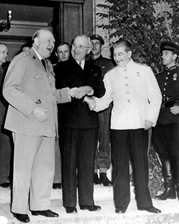Introduction to the Cold War

As most European countries faced a long road to recovery from the devastation of WWII, the United States emerged as a lone superpower. Within a few years, however, the Soviet Union challenged the status of America’s dominance. This rivalry created what is dubbed the bipolar world as each side competed to impose its political and economic ideologies upon others. Nations began to align themselves with either superpower and those who resisted Western or Eastern influence were dubbed “third world nations.”
Macrohistory: The United Nations (2 pages)
Macrohistory: Victors against the Defeated (7 pages)
Cold War. Films on Demand. 2009. Accessed October 31, 2020. https://ccco.idm.oclc.org/login?url=https://fod.infobase.com/PortalPlaylists.aspx?wID=151823&xtid=47587.
Potsdam and Atomic Bomb [via Films on Demand]
If you get an error saying the video can’t be authenticated, use the link found in the title to view it.
Distrust and misunderstanding between the United States and the Soviet Union gradually developed into the Cold War when the two nations failed to resolve three crucial issues: control of postwar Europe, economic aid, and nuclear disarmament. Although an all-out war between the two nuclear powers was avoided, there were ample examples of proxy conflicts.
Cold War. Films on Demand. 2009. Accessed October 31, 2020. https://ccco.idm.oclc.org/login?url=https://fod.infobase.com/PortalPlaylists.aspx?wID=151823&xtid=47587.
Berlin Blockagde [via Films on Demand]
If you get an error saying the video can’t be authenticated, use the link found in the title to view it.
Macrohistory: Cold War: 1945-49 (8 pages)
Macrohistory: Cold War: 1953-60 (11 pages)
Macrohistory: Cold War: the Kennedy Years (7 pages)
Macrohistory: Vietnam, 1964-75 (4 pages)
Cold War. Films on Demand. 2009. Accessed October 31, 2020. https://ccco.idm.oclc.org/login?url=https://fod.infobase.com/PortalPlaylists.aspx?wID=151823&xtid=47587.
French Withdrawal and Division of Vietnam [via Films on Demand]
If you get an error saying the video can’t be authenticated, use the link found in the title to view it.
Historiography and Origins of the Cold War
Scholarly Debate on the Origins of the Cold War
Three schools of thought attempt to understand the origins of the Cold War between the United States and the Soviet Union following the end of World War I – they are called the Traditionalists, the Revisionists, and the Post-Revisionists. Each group argues that one side or the other is to blame for the start of the Cold War.
Walton, “Who Was At Fault for the Cold War?”
“Who Started the Cold War? An Exchange by Steven J. Cagney, Reply by Arthur Schlesinger Jr.”
References
Walton, Sam. “Who Was at Fault for the Cold War?” University of Sussex Undergraduate History Journal 1 (2011). https://www.sussex.ac.uk/webteam/gateway/file.php?name=who-was-at-fault-for-the-cold-war.pdf&site=15.
“Who Started the Cold War? An Exchange by Steven J. Cagney, Reply by Arthur Schlesinger Jr.” Accessed August 20, 2018. https://www.nybooks.com/articles/1980/03/20/who-started-the-cold-war-an-exchange/.
